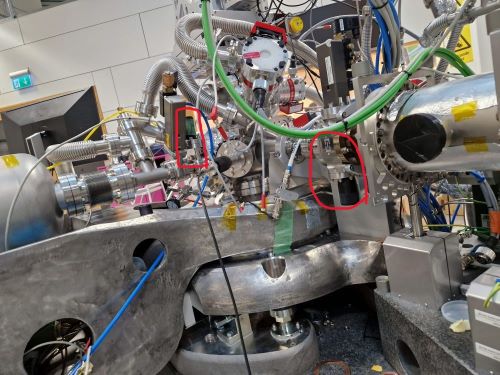Liqui Jet Chamber
liquid jet is nessesary to start while the chamber is air pressure.
Start liquid jet
Start vacuum pumping
Find jet by mapping
Diagram of the differential pumping

How to start liquid jet
It is not possible to start a jet in a vacuum by freezing of the jet while starting. Therefore, the following procedure needs to start from atmospheric pressure.
move the jet nozzle near the separation disc between the cold trap and the upper chamber (typically 5-10mm lower than the beam poison. Please check with the camera to avoid a crash of the nozzle with the disc.)

star liquid flow and wait for pressure to increase well. Typically pressure reaches 30-50 bar for water, depending on the capillary inner diameter. Increase the flow rate till the jet becomes straight enough. Normally, higher pressure (i.e. higher flow rate) makes the jet strait.
start vacuum pumping (see procedure for pumping below)
move the jet nozzle up and start tuning the position of the jet by monitoring downstream PD.

How to start pumping
Open angle valves (1 and 2 after) for inner chamber pumping.
Open angle valves (3 and 4) for the inner differential pumping and the outer chamber pump.
Start three TMPs for the inner differential pumping and the outer chamber
Wait for the vacuum to recover.
How to stop pumping
Confirm valves to the beamline and emission spectrometer are closed. It is recommended to close 2 gate valves from the endstation main chamber.
If filter valves were used, remove the filter( i.e. open the filter valve) just after closing the gate valves to prevent damage to the thin film windows.

Close angle valve(4 and 3) for outer chamer pumping.
Close angle valve(2 and 1) for innter chamber pump.
Stop two TMPs for outer chamber pumping
Wait for the chamber will be vented with air.
Procedure to Cleaning cold trap
Note: The chamber is required to be in air pressure before starting.
Remove the nitrogen dewar at the bottom of the cold trap after removing the lift under the dewar. Since the gap under the chamber is narrow, you must tilt the drawer to do this. Please use cryogenic gloves for your safety.
Position the pot with water beneath the cold trap with the hot plate using the lift.
If necessary, add liquid nitrogen to the solvent cold trap of the sample remover setup.
Locate the swagelock port (chemical waste transfer port) with a blank plug attached to the cold trap. Connect the line from the sample remover setup to this port (tightening by hand is enough).
Connect the heater and thermocouples to the temperature controller, and activate the heating of the pot to around 50-60 degrees Celsius.
when the temperature reaches around 40, start the small diaphragm pump of the sample remover setup to begin removing liquid from the cold trap.
Wait for the sample to melt and for it to flow into the glass canister. This whole process may take 20-40 minutes including heating time, depending on the quantity of samples in the cold trap. If the glass canister becomes full, stop the liquid flow with a valve and the pump, replace the glass canister and resume pumping.
Once all the samples have been removed from the cold trap, stop heating the pot, turn off the small pump of the sample remover setup, and carefully remove the pot and hot plate. Be cautious, as the hot plate will still be hot. Place a blank plug on the red line and seal it.
Detach the glass canister from the sample remover and securely close the cap. Temporarily store the chemical waste solutions in the canister, and dispose of them according to chemical safety regulations.
The system is now ready to start pumping the chamber.
Note: After cleaning the cold trap, the vacuum pressure in the chamber will initially be around 1 mbar due to solvent vapors when pumping starts. However, this pressure will improve once the cooling of the cold trap begins. The outer chamber should soon reach 1E-3 mbar and will gradually improve to around 5E-4 as cooling continues.